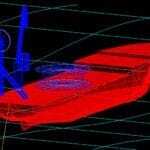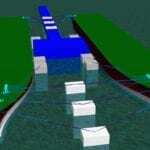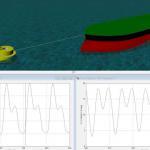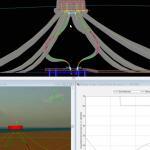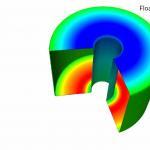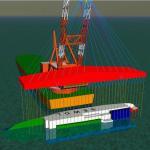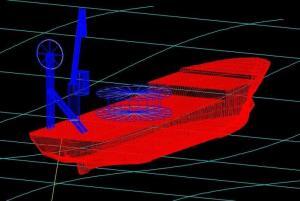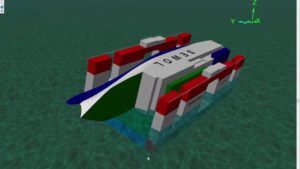Example of hydrodynamic analysis at CALM buoy SPM with VLCC tanker moored when a squall, or sudden wind shift, occurs. The time domain analysis is performed with OrcaFlex and hydrodynamic characteristics (diffraction forces, added mas and radiation damping) are taken from analyses in the frequency domain with MDL Hydro.
Ship hydrodynamic and aerodynamic drag terms are calculated by STA using shallow water effects and OCIMF coefficients.
Published by Stewart Technology Associates on June 20, 2016
View list of STA software.
The portfolio item below provides a short OrcaFlex Tutorial example of Mooring Analysis.
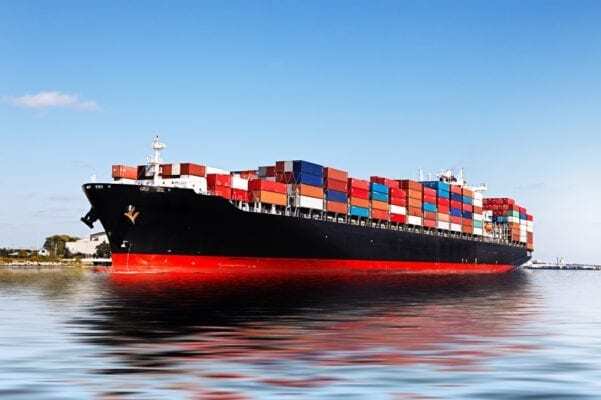
Water can behave in many different ways, depending on the circumstances, and any structure or equipment that is in a marine environment or to be used near the water, must be thoroughly prepared for the forces that will operate on it. These forces are constantly changing and include tidal forces, wave action, undersea currents, high pressures, corrosion and chemical reactions. If a structure or piece of equipment is not designed properly for a marine setting, it could have a significantly reduced lifespan, require increased maintenance and pose a threat to nearby personnel.
Industry personnel can use hydrodynamic analysis to improve marine equipment and structure designs. By modeling the behavior of the water and the structure or equipment exposed to it, design problems and structural deficiencies can be discovered, and the design can be improved before the equipment or structure is put into production. This process can save large amounts of time and money, and can improve the safety of marine structures and equipment.
Here are a few examples of projects that can benefit from thorough hydrodynamic analysis:
#1 Oil Rig Design
Large, off-shore oil rigs are often limited-production designs, with only a few examples actually being built. This means it is difficult to test the designs thoroughly before production, and any mistakes in the design can be difficult and expensive to repair later. By using hydrodynamic analysis, the manufacturer can thoroughly test the design before it is put into production, and improve it to minimize any problems.
The hydrodynamic analysis will model the effects of the marine environment on every part of the oil rig, from the anchors that tie it to the seafloor, to the platform legs, risers and superstructure. It can pinpoint structural deficiencies, where forces like wave action slowly wear away at sensitive components, such as moving joints, and eventually cause dangerous structural failures or prolonged maintenance problems. This allows the designers and engineers to redesign these components to better withstand the forces at work in the marine environment, reducing maintenance costs, increasing the design life and protecting the safety of the personnel.
#2 Pump Design
Pumps are critical in a marine environment. Bilge pumps remove excess water from a ship’s hull to prevent an over-accumulation that could cause the ship to sink. Fresh water pumps circulate drinking water through the plumbing for ship personnel, and other pumps may be used for fire protection. Oil pumps are used to keep the moving parts of a ship lubricated, or to transfer oil from production wells to tankers. Fuel pumps provide ships and generators with the fuel they need to run.
Pumps used in a marine environment must be able to withstand corrosion and electrochemical reactions caused by saltwater exposure, and they must be able to transfer fluids quickly and efficiently without overheating and failing. Hydrodynamic analysis can be used to model both the behavior of water on the exterior of the pump and the behavior of liquids as they travel through the pump.
The models can be used to design pumps which are better suited to the forces at work in a marine environment, making them stronger and more resistant to the effects of pressure and corrosion that cause maintenance problems. They can also be used to increase the efficiency of the pump, by showing how the fluids travel through the body and the impellers. By using the results to eliminate unnecessary cavitation and friction, the pump design can be made much more efficient, saving energy, reducing maintenance requirements, and extending the pump’s lifespan.
#3 Accident Reconstruction
Working in a marine environment can be especially dangerous for personnel and equipment. Bad weather, rogue waves, fire, equipment failures and other common problems can quickly lead to dangerous situations in the contained environment of a ship, drilling rig or other marine platforms. Accidents can and do happen, including collisions, fires, oil spills, sunken vessels and other catastrophes. Determining the cause of an accident and the results are often the key to improving marine designs and preventing similar accidents in the future.
Hydrodynamic analysis is one of the most powerful tools for determining the cause of a marine accident. The process can be used to model the behavior of the water and any structures, vessels, or equipment that are in the water. It can help determine why two ships collided using accurate modeling, which part of a structure failed, why fire protections systems malfunctioned during an emergency, or how an oil leak was caused and where the oil will be traveling.
With accurate modeling, hydrodynamic analysis in conjunction with other tools can reconstruct every variable at play during an accident, and determine the cause and effect of each action taken. The results can be used to improve the designs of marine equipment and structures to prevent similar accidents in the future, to institute new safety procedures that minimize casualties, and to take further action to protect the safety of ship personnel and minimize liability issues.
Other Applications
These are just a few of the ways that hydrodynamic analysis can be employed in real-world applications. It can also be used to improve the designs of sea-faring vessels, mooring systems, sub-sea pipelines, floating pipelines, drilling risers, anchors, mooring lines, liquid-storage systems, buoys, marine weapon systems, off-shore wind turbines and wave power generators. Furthermore, it can be used to help during oil spill cleanup or containment operations, for forensic analysis, marine training simulations, risk assessments, financial assessments, emergency preparedness and accident prevention. Hydrodynamic analysis is a versatile tool, and it has many critical applications across multiple industries, including oil and gas production, energy production, shipping services, defense, maritime entertainment and oceanography.
With so many applications, hydrodynamic analysis is very important to any marine based-operation, and through its accurate modeling, it can help improve the design and operation of many marine-based structures, tools and equipment. It can help cut design costs and minimize production delays, and improve the safety of marine-based personnel.
Sources:


